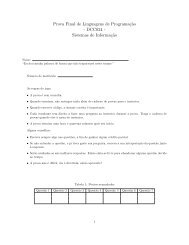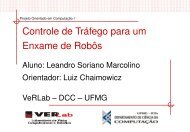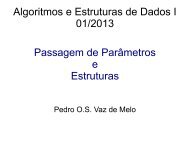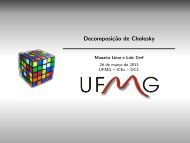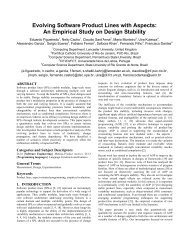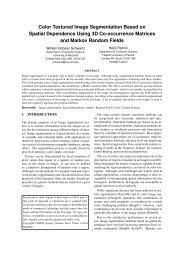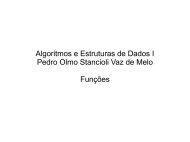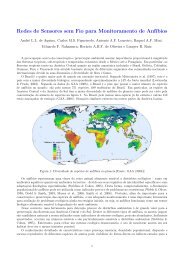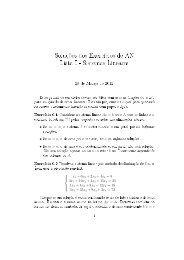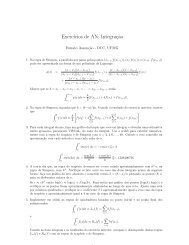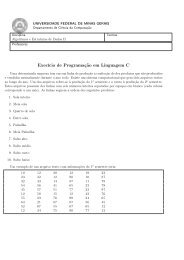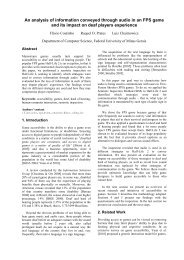Simple and Space-Efficient Minimal Perfect Hash Functions * - Liacs
Simple and Space-Efficient Minimal Perfect Hash Functions * - Liacs
Simple and Space-Efficient Minimal Perfect Hash Functions * - Liacs
Create successful ePaper yourself
Turn your PDF publications into a flip-book with our unique Google optimized e-Paper software.
2.1 Theoretical Results<br />
Fredman <strong>and</strong> Komlós [11] proved that at least n log e+loglog u−O(log n) bits are<br />
required to represent a MPHF (in the worst case over all sets of size n), provided<br />
that u ≥ n α for some α > 2. Logarithms are in base 2. Note that the two last<br />
terms are negligible under the assumption log u ≪ n. In general, for m > n the<br />
space required to represent a PHF is around (1 + (m/n − 1)ln(1 − n/m))nloge<br />
bits. A simpler proof of this was later given by Radhakrishnan [20].<br />
Mehlhorn [17] showed that the Fredman-Komlós bound is almost tight by<br />
providing an algorithm that constructs a MPHF that can be represented with<br />
at most n log e + log log u + O(log n) bits. However, his algorithm is far from<br />
practice because its construction <strong>and</strong> evaluation time is exponential in n.<br />
Schmidt <strong>and</strong> Siegel [21] proposed the first algorithm for constructing a MPHF<br />
with constant evaluation time <strong>and</strong> description size O(n + log log u) bits. Their<br />
algorithm, as well as all other algorithms we will consider, is for the Word RAM<br />
model of computation [12]. In this model an element of the universe U fits into<br />
one machine word, <strong>and</strong> arithmetic operations <strong>and</strong> memory accesses have unit<br />
cost. From a practical point of view, the algorithm of Schmidt <strong>and</strong> Siegel is<br />
not attractive. The scheme is complicated to implement <strong>and</strong> the constant of the<br />
space bound is large: For a set of n keys, at least 29n bits are used, which means a<br />
space usage similar in practice to the best schemes using O(n log n) bits. Though<br />
it seems that [21] aims to describe its algorithmic ideas in the clearest possible<br />
way, not trying to optimize the constant, it appears hard to improve the space<br />
usage significantly.<br />
More recently, Hagerup <strong>and</strong> Tholey [13] have come up with the best theoretical<br />
result we know of. The MPHF obtained can be evaluated in O(1) time<br />
<strong>and</strong> stored in n log e + log log u + O(n(log log n) 2 / log n + log log log u) bits. The<br />
construction time is O(n+log log u) using O(n) words of space. Again, the terms<br />
involving u are negligible. In spite of its theoretical importance, the Hagerup <strong>and</strong><br />
Tholey [13] algorithm is also not practical, as it emphasizes asymptotic space<br />
complexity only. (It is also very complicated to implement, but we will not go<br />
into that.) For n < 2 150 the scheme is not well-defined, as it relies on splitting the<br />
key set into buckets of size ˆn ≤ log n/(21 loglog n). If we fix this by letting the<br />
bucket size be at least 1, then buckets of size one will be used for n < 2 300 , which<br />
means that the space usage will be at least (3 log log n+log7)n bits. For a set of<br />
a billion keys, this is more than 17 bits per element. Thus, the Hagerup-Tholey<br />
MPHF is not space efficient in practical situations. While we believe that their<br />
algorithm has been optimized for simplicity of exposition, rather than constant<br />
factors, it seems difficult to significantly reduce the space usage based on their<br />
approach.<br />
2.2 Practical Results<br />
We now describe some of the main “practical” results that our work is based on.<br />
They are characterized by simplicity <strong>and</strong> (provably) low constant factors.



